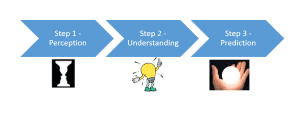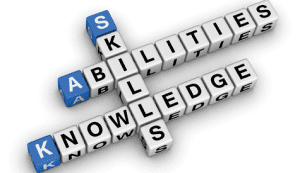 The development of situational awareness happens on a three-tiered continuum. It begins with perceiving your environment. Then, what is perceived must be understood (and this is not as simple as it may appear). Finally, understanding is used to predict the future. Summarizing, the three-step process: Perception – Understanding – Prediction. This article provides an example for how flawed expectations can impact prediction.
The development of situational awareness happens on a three-tiered continuum. It begins with perceiving your environment. Then, what is perceived must be understood (and this is not as simple as it may appear). Finally, understanding is used to predict the future. Summarizing, the three-step process: Perception – Understanding – Prediction. This article provides an example for how flawed expectations can impact prediction.

Prediction
To predict is to forecast – to anticipate – future events before they happen. Previous training and experience play a big role in helping you make accurate predictions of future events. As predictions are made, they are aligned with expectations. The expectations are the anticipated outcomes. For example, at a structure fire, a prediction may be that an interior attack team will be able to extinguish the fire. The expectations may then include: The visible fire disappears and the black smoke turns into white smoke.
Staffing

The success of any emergency incident is contingent on our ability to assemble a well-trained team of responders (in a timely manner) and following a plan to achieve a commonly understood objective. This requires the commander to hold certain expectations about how teams will perform their jobs at the emergency.
In other words, as the commander forms Level 3 situational awareness – predicting the future – the expectations of crew performance becomes an important component. The commander must form expectations about how long it will take various crews to accomplish various tasks (like making black smoke turn into white smoke). This helps the commander look into the future and see (using the “mind’s eye”) anticipated outcomes.
Not All Crews Are Created Equal
While we may want all crews to be created equal, the reality is, there can be a wide variation in the knowledge, skills, abilities, fitness and stamina of crewmembers. This variation then influences the collective ability of each crew to complete a task in the time expected.
 When an assignment is given to a crew, there is, concurrently, an expectation that the task will be completed, successfully, within a certain timeframe. If consideration is not given to the variation in crewmember abilities, a commander can easily fall prey to the belief that all crews can accomplish all tasks with equal abilities and within the same time constraints. This simply is not true and to think so – or to be indifferent to this fact – can quickly lead to flawed Level 3 Situational Awareness.
When an assignment is given to a crew, there is, concurrently, an expectation that the task will be completed, successfully, within a certain timeframe. If consideration is not given to the variation in crewmember abilities, a commander can easily fall prey to the belief that all crews can accomplish all tasks with equal abilities and within the same time constraints. This simply is not true and to think so – or to be indifferent to this fact – can quickly lead to flawed Level 3 Situational Awareness.
Dr. Gasaway’s Advice

While conducting a size-up and preparing to make assignments, assess the quantity and quality of each crew. Expectations of outcomes should be customized to each incident and to each crew.
Stated another way, if you are playing poker, your betting strategy is based on the cards you are dealt. When your hand is strong, your confidence for success (a win) will be higher. When your hand is weaker, you should be concerned that the risk of loss will be greater. The same is true for staffing. Assess each crew separately.
 Action Items
Action Items
1. Discuss how you might be able to assess variations in crew quality.
2. Discuss the impact variations in crew quality can have on expectations, outcomes and incident safety.
3. Discuss ways to overcome variations in crew quality.
_____________________________________________________

If you are interested in taking your understanding of situational awareness and high-risk decision making to a higher level, check out the Situational Awareness Matters Online Academy.
CLICK HERE for details, enrollment options and pricing.
__________________________________
Share your comments on this article in the “Leave a Reply” box below. If you want to send me incident pictures, videos or have an idea you’d like me to research and write about, contact me. I really enjoy getting feedback and supportive messages from fellow first responders. It gives me the energy to work harder for you.
Thanks,

Email: Support@RichGasaway.com
Phone: 612-548-4424
SAMatters Online Academy
Facebook Fan Page: www.facebook.com/SAMatters
Twitter: @SAMatters
LinkedIn: Rich Gasaway
YouTube: SAMattersTV
iTunes: SAMatters Radio
